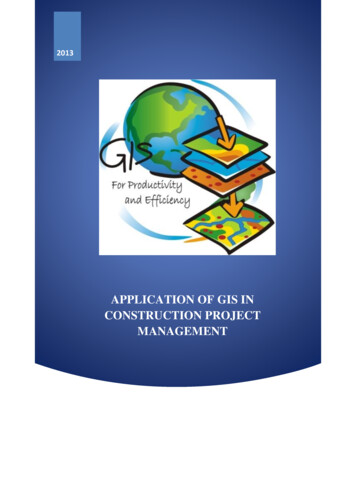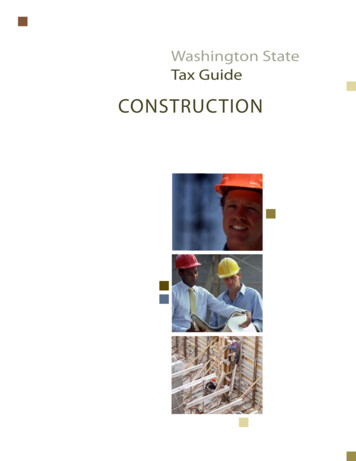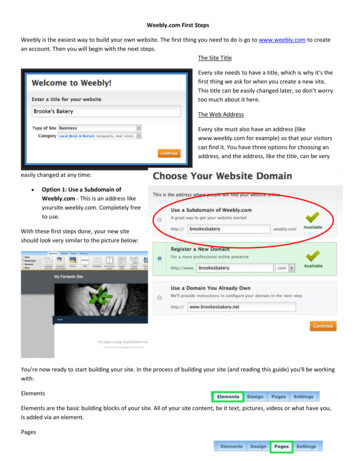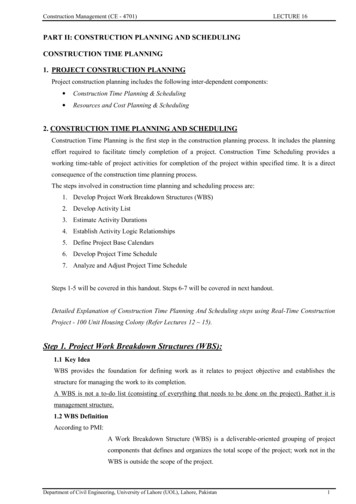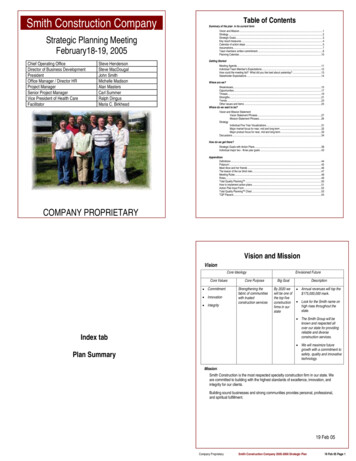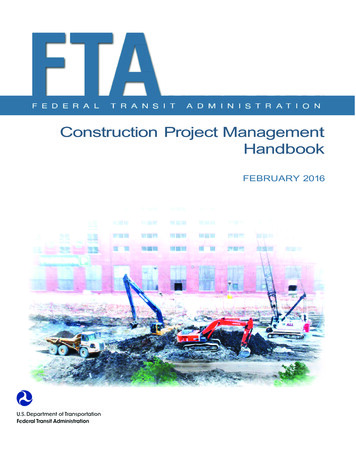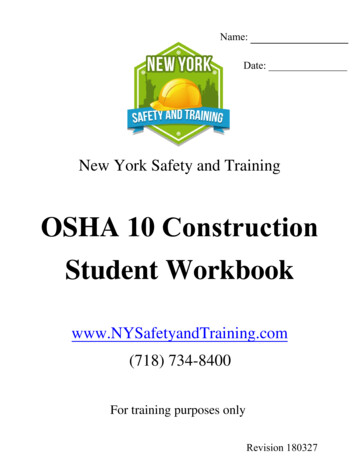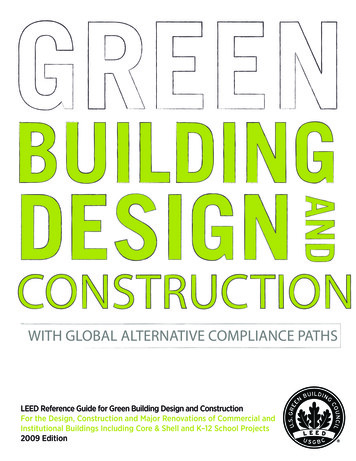
Transcription
CONSTRUCTIONWITH GLOBAL ALTERNATIVE COMPLIANCE PATHSLEED Reference Guide for Green Building Design and ConstructionFor the Design, Construction and Major Renovations of Commercial andInstitutional Buildings Including Core & Shell and K–12 School Projects2009 Edition
The built environment has a profound impact on our natural environment, economy, health, andproductivity. Breakthroughs in building science, technology, and operations are now available todesigners, builders, operators, and owners who want to build green and maximize both economicand environmental performance.Through the LEED green building certification program, the U.S. Green Building Council(USGBC) is transforming the built environment. The green building movement offers anunprecedented opportunity to respond to the most important challenges of our time, includingglobal climate change, dependence on non sustainable and expensive sources of energy, andthreats to human health. The work of innovative building professionals is a fundamental drivingforce in the green building moment. Such leadership is a critical component to achieving USGBC’smission of a sustainable built environment for all within a generation.USGBC MEMBERSHIPUSGBC’s greatest strength is the diversity of our membership. USGBC is a balanced, consensusbased nonprofit with more than 18,000 member companies and organizations representing theentire building industry. Since its inception in 1993, USGBC has played a vital role in providing aleadership forum and a unique, integrating force for the building industry. USGBC’s programs havethree distinguishing characteristics:Committee-basedThe heart of this effective coalition is our committee structure, in which volunteer membersdesign strategies that are implemented by staff and expert consultants. Our committees providea forum for members to resolve differences, build alliances, and forge cooperative solutions forinfluencing change in all sectors of the building industry.Member-drivenMembership is open and balanced and provides a comprehensive platform for carrying outimportant programs and activities. We target the issues identified by our members as thehighest priority. We conduct an annual review of achievements that allows us to set policy, revisestrategies, and devise work plans based on members’ needs.Consensus-focusedWe work together to promote green buildings, and in doing so, we help foster greater economicvitality and environmental health at lower costs. We work to bridge ideological gaps betweenindustry segments and develop balanced policies that benefit the entire industry.Contact the U.S. Green Building Council2101 L Street, NWSuite 500Washington, DC 20037(800) 795-1747 Office(202) 828-5110 Faxwww.usgbc.org2009 EDITIONLEED REFERENCE GUIDE FOR BUILDING DESIGN & CONSTRUCTIONWITH GLOBAL ALTERNATIVE COMPLIANCE PATHSi
COPYRIGHTCopyright 2014 by the U.S. Green Building Council. All rights reserved.DISCLAIMERNone of the parties involved in the funding or creation of the Reference Guide supplement,including the USGBC, its members, its contractors, or the United States government, assumeany liability or responsibility to the user or any third parties for the accuracy, completeness, oruse of or reliance on any information contained in the Reference Guide supplement, or for anyinjuries, losses, or damages (including, without limitation, equitable relief) arising from such useor reliance. Although the information contained in the Reference Guide supplement is believed tobe reliable and accurate, all materials set forth within are provided without warranties of any kind,either express or implied, including but not limited to warranties of the accuracy or completenessof information contained in the training or the suitability of the information for any particularpurpose.U.S. Green Building Council2101 L Street, NWSuite 500Washington, DC 20037TRADEMARKLEED is a registered trademark of the U.S. Green Building Council.ISBN # 978-1-932444-62-9iiLEED REFERENCE GUIDE FOR BUILDING DESIGN & CONSTRUCTIONWITH GLOBAL ALTERNATIVE COMPLIANCE PATHS2009 EDITION
PrefaceiIntroductionvI. Why Make Your Building Green?vII. Leed Green Building Rating SystemvIII. Overview And ProcessvIV. Leed Online Documentation RequirementsvV. Certification Applicationv VI. Certification StrategyvVII. Exemplary Performance StrategiesviVIII. Regional PriorityviIX. Tools For Registered ProjectsviX. How To Use This Reference GuideviXI. Credit SubstitutionviSustainable Sites (SS)1Prerequisite 2Environmental Site Assessment3Credit 1Site Selection7Credit 3Brownfield Redevelopment11Credit 4.1Alternative Transportation—Public Transportation Access15Credit 6.1Stormwater Design—Quantity Control19Credit 7.1Heat Island Effect—Nonroof26Credit 7.2Heat Island Effect—Roof32Water Efficiency (WE)39Credit 141Water Efficient LandscapingEnergy and Atmosphere (EA)45Prerequisite 2Minimum Energy Performance47Credit 1Optimize Energy Performance51Credit 6Green Power57Materials and Resources (MR)61Credit 2Constrution Waste Management63Credit 5Regional Materials67Indoor Environmental Quality (IEQ)71Prerequisite 1Minimum Indoor Air Quality Performance73Prerequisite 2Environmental Tobacco Smoke (ETS) Control79Prerequisite 3Minimum Acoustical Performance83Credit 1Outdoor Air Delivery Monitoring87Credit 2Increased Ventilation91Credit 3-3.1Construction Indoor Air Quality Management Plan—During Construction95Credit 4 & 4.3Low-Emitting Materials992009 EDITIONLEED REFERENCE GUIDE FOR BUILDING DESIGN & CONSTRUCTIONWITH GLOBAL ALTERNATIVE COMPLIANCE PATHSiii
Credit 5Indoor Chemical and Pollutant Source Control109Credit 6 & 6.2Controllability of Systems—Thermal Comfort113Credit 7 & 7.1Controllability of Systems—Thermal Comfort117Credit 7.2Thermal Comfort—Verification121Credit 9Enhanced Acoustical Performance125Glossary128LEED 2009 FOR NEW CONSTRUCTION, CORE & SHELL, AND SCHOOLS100 base points; 6 possible innovation in Design and 4 Regional Priority pointsCertified40–49 pointsSilver50–59 pointsGold60–79 pointsPlatinum80 points and above*Credit not applicable to all Rating systems, please refer to the credit for more details.ivLEED REFERENCE GUIDE FOR BUILDING DESIGN & CONSTRUCTIONWITH GLOBAL ALTERNATIVE COMPLIANCE PATHS2009 EDITION
I. WHY MAKE YOUR BUILDING GREEN?See the LEED 2009 Green Building Design and Construction Reference Guide for this section ofthe Introduction.II. LEED GREEN BUILDING RATING SYSTEMSee the LEED 2009 Green Building Design and Construction Reference Guide for this section ofthe Introduction.III. OVERVIEW AND PROCESSSee the LEED 2009 Green Building Design and Construction Reference Guide for additionalguidance related to the Overview and Process section.When to Use LEED 2009 Global Alternative Compliance PathsAlternative Compliance Paths (ACPs) to LEED credits provide additional options or approachesthat address unique circumstances and accommodate advancements in science and technology.ACPs allow LEED to be more flexible and applicable to a wider range of projects. The LEED 2009BD&C Global ACPs were developed for new construction and major renovations of commercialand institutional buildings, core and shell developments, and schools. These Global ACPs can beapplied at the discretion of the project team, based on applicability; they are not mandatory for anyproject. Some Global ACPs are available only for projects outside the U.S., and others are availablefor all LEED projects regardless of location, as indicated in the credit language.Projects may use none, some, or all of the LEED 2009 Global ACPs and do not need to apply themconsistently across credits unless noted in the credit language. Each credit category’s Overviewsection includes a table identifying which credits have Global ACPs.For specific guidance on which rating system to use, see the LEED 2009 Green Building Design andConstruction Reference Guide.IV. LEED ONLINE DOCUMENTATION REQUIREMENTSSee the LEED 2009 Green Building Design and Construction Reference Guide for this section ofthe Introduction.V. CERTIFICATION APPLICATIONSee the LEED 2009 Green Building Design and Construction Reference Guide for this section ofthe Introduction.VI. CERTIFICATION STRATEGYSee the LEED 2009 Green Building Design and Construction Reference Guide for this section ofthe Introduction.2009 EDITIONLEED REFERENCE GUIDE FOR BUILDING DESIGN & CONSTRUCTIONWITH GLOBAL ALTERNATIVE COMPLIANCE PATHSv
VII. EXEMPLARY PERFORMANCE STRATEGIESSee the LEED 2009 Green Building Design and Construction Reference Guide for this section ofthe Introduction.VIII. REGIONAL PRIORITYSee the LEED 2009 Green Building Design and Construction Reference Guide for this section ofthe Introduction.IX. TOOLS FOR REGISTERED PROJECTSSee the LEED 2009 Green Building Design and Construction Reference Guide for this section ofthe Introduction.X. HOW TO USE THIS REFERENCE GUIDESee the LEED 2009 Green Building Design and Construction Reference Guide for additionalguidance.The LEED 2009 BD&C Global Alternative Compliance Path Reference Guide Supplement isa supporting document to the LEED Global ACPs. This guide helps project teams understandthe criteria, the reasons behind them, strategies for implementation, and documentationrequirements. It includes examples of strategies that can be used in each category and additionalresources. It does not provide an exhaustive list of strategies for meeting the criteria or all theinformation that a project team needs to determine the applicability of a credit to the project.The LEED 2009 BD&C Global Alternative Compliance Path Reference Guide Supplement shouldbe consulted in conjunction with the LEED 2009 Green Building Design and ConstructionReference Guide. Information in the reference guide is not repeated in this supplement, whichfocuses instead on the following: information specific to considerations for projects outside the U.S. new information for existing credits with new Alternative Compliance PathsXI. CREDIT SUBSTITUTIONProject teams wishing to use LEED v4 credits in lieu of LEED 2009 credits may now do so. Tosubstitute a LEED v4 credit for a LEED 2009 credit, project teams must consult the list of approvedcredit substitutions available on USGBC.org and download the LEED v4 sample credit form.Project teams must then complete and upload the sample form into LEED Online within the LEED2009 credit they are substituting.Credit substitutions are available for all projects, regardless of location. However, projectsoutside the U.S. may find credit substitutions particularly helpful for LEED v4 credits that addresscircumstances for projects outside the U.S.IMPORTANT! This reference guide supplement contains only the reference guide sections that pertain toprojects using the LEED 2009 Global Alternative Compliance Paths. Use this supplement alongside theLEED Reference Guide for Green Building Design and Construction for complete credit information. For theomitted sections, refer to the main reference guide.viLEED REFERENCE GUIDE FOR BUILDING DESIGN & CONSTRUCTIONWITH GLOBAL ALTERNATIVE COMPLIANCE PATHS2009 EDITION
SS OVERVIEWOVERVIEWSee the LEED 2009 Green Building Design and Construction Reference Guide for additionalguidance.Project teams outside the U.S. face many of the same challenges as their American counterpartswhen determining where to locate a new project. However, American codes and regulations oftenprove difficult to apply abroad. The Global Alternative Compliance Paths for Sustainable Sitesallow project teams outside the U.S. to select local equivalents to the prescribed U.S. codes andregulations for select credits. In many cases this will lower overall project costs by reducing therequired documentation.Local equivalent standards can be used in place of U.S. government regulations for Schools SSPrerequisite 2 (Environmental Site Assessment), SS Credit 1 (Site Selection), and SS Credit 3(Brownfield Redevelopment). Project teams outside the U.S. can use a local code or regulation if itmeets the intent of the prerequisite or credit.A new option for SS Credit 4.1 (Alternative Transportation—Public Transportation Access) allowsproject teams to include additional vehicle types when calculating alternative transportation usefor building occupants. The new option for SS Credit 6.1 (Stormwater Design—Quantity Control)allows project teams to calculate stormwater runoff reduction using a method that may be moreappropriate in areas where it is difficult to calculate the 1- and 2-year 24-hour design storm.Table 1. SS Credits with Global Alternative Compliance PathsCreditTitleSS Prerequisite 1Construction Activity Pollution PreventionSS Prerequisite 2Environmental Site AssessmentSS Credit 1Site SelectionSS Credit 2Development Density and CommunityConnectivitySS Credit 3Brownfield RedevelopmentSS Credit 4.1Alternative Transportation—PublicTransportation AccessSS Credit 4.2Alternative Transportation—Bicycle Storageand Changing RoomsSS Credit 4.3Alternative Transportation—Low-Emitting andFuel-Efficient VehiclesSS Credit 4.4Alternative Transportation—Parking CapacitySS Credit 5.1Site Development—Protect or Restore HabitatSS Credit 5.2Site Development—Maximize Open SpaceSS Credit 6.1Stormwater Design—Quantity ControlSS Credit 6.2Stormwater Design—Quality Control2009 EDITIONNCSchoolsCSLEED REFERENCE GUIDE FOR BUILDING DESIGN & CONSTRUCTIONWITH GLOBAL ALTERNATIVE COMPLIANCE PATHSIMPORTANT! This referenceguide supplement containsonly the reference guidesections that pertain toprojects using the LEED 2009Global Alternative CompliancePaths. Use this supplementalongside the LEED ReferenceGuide for Green BuildingDesign and Construction forcomplete credit information.For the omitted sections, referto the main reference guide.1
SS OVERVIEW2CreditTitleSS Credit 7.1Heat Island Effect—NonroofSS Credit 7.2Heat Island Effect—RoofSS Credit 8Light Pollution ReductionSS Credit 9Tenant Design and Construction GuidelinesSS Credit 9Site Master PlanSS Credit 10Joint Use of facilitiesLEED REFERENCE GUIDE FOR BUILDING DESIGN & CONSTRUCTIONWITH GLOBAL ALTERNATIVE COMPLIANCE PATHSNCSchoolsCS2009 EDITION
ENVIRONMENTAL SITE ASSESSMENTPrerequisitePointsSS PREREQUISITE 2NCSCHOOLSCSSS Prerequisite 2SS Prerequisite 2SS Prerequisite 2NARequiredNAIntentTo ensure that the site is assessed for environmental contamination and if contaminated, thatthe environmental contamination has been remediated to protect children’s health.RequirementsSCHOOLSConduct a Phase I Environmental Site Assessment (as described in ASTM E1527-05) todetermine whether environmental contamination exists at the site. If contamination issuspected conduct a Phase II Environmental Site Assessment (as described in ASTM E190397, 2002). Projects outside the U.S. may use a local equivalent to ASTM E1527-05 Phase IEnvironmental Site Assessment and ASTM E 1903-97 Phase II EnvironmentalSite Assessment.Schools sites that are contaminated by past use as a landfill are ineligible for LEEDcertification. If a site is otherwise contaminated, it must be remediated to meet local, state,or federal EPA region residential (unrestricted) standards, whichever is most stringent.Documentation from the authority (such as EPA’s “Ready for Reuse” document)mustbe provided to prove that safe levels of contamination have been achieved. Because theremediation process leads to significant environmental benefit, 1 point in SS Credit 3:Brownfield Redevelopment can be achieved for successful documented remediation ofthe site.IMPORTANT! This referenceguide supplement containsonly the reference guidesections that pertain toprojects using the LEED 2009Global Alternative CompliancePaths. Use this supplementalongside the LEED ReferenceGuide for Green BuildingDesign and Construction forcomplete credit information.For the omitted sections, referto the main reference guide.2009 EDITIONLEED REFERENCE GUIDE FOR BUILDING DESIGN & CONSTRUCTIONWITH GLOBAL ALTERNATIVE COMPLIANCE PATHS3
SSNCNASCHOOLSPrerequisite 2CSNA1. Benefits and Issues to ConsiderSee the LEED 2009 Green Building Design and Construction Reference Guide for information onenvironmental and economic issues related to this prerequisite.2. Related CreditsSee the LEED 2009 Green Building Design and Construction Reference Guide for a list of creditsrelated to this prerequisite.3. Summary of Referenced StandardsNo new standards are referenced; see the LEED 2009 Green Building Design and ConstructionReference Guide for summaries of the ASTM E1527-05, Phase I Environmental Site Assessment,and ASTM E1903-97, Phase II Environmental Site Assessment. If a local equivalent to the ASTMPhase I or Phase II site assessment has been selected, substitute that standard for the listedstandards.4. ImplementationIf a local equivalent to the ASTM Phase I or Phase II Environmental Site Assessment has beenselected, ensure that it is the most widely used and accepted by remediation experts in the projectcountry. It should, at a minimum, test for the presence of any hazardous substances on theproperty, as indicated through present release, past release, or threat of release into the ground,ground water, surface water, or any structures on the property. If the local equivalent assessmentdetermines that critical levels of contaminants are present at the project site, the site must beremediated to unrestricted use standards. Equivalency means meeting the criteria of the ASTMPhase I or Phase II Environmental Site Assessment listed in the Implementation section of theLEED 2009 Green Building Design and Construction Reference Guide.5. Timeline and TeamSee the LEED 2009 Green Building Design and Construction Reference Guide for guidance relatedto this prerequisite.6. CalculationsThere are no calculations associated with this prerequisite.7. Documentation GuidanceAs a first step in preparing to complete the LEED Online documentation requirements, workthrough the following measures. Refer to LEED Online for the complete descriptions of allrequired documentation. Retain copies of the executive summaries from all local equivalent environmental siteassessments performed. If remediation efforts were necessary, prepare a description of the efforts. Acquire documentation from the local governing authority showing that remediation tounrestricted use standards has been completed. The remediation efforts undertaken must atleast match the stringency of the U.S. Environmental Protection Agency (EPA) requirementsfor residential (unrestricted) use. Residential land use is considered the most restrictiveland use by EPA; it assumes that no contaminants are left on site to which children could beexposed. Provide documentation from the remediation expert or local authority stating that there areno contaminants remaining at the project site.4LEED REFERENCE GUIDE FOR BUILDING DESIGN & CONSTRUCTIONWITH GLOBAL ALTERNATIVE COMPLIANCE PATHS2009 EDITION
8. ExamplesThere are no examples for this prerequisite.SSNCSCHOOLS9. Exemplary PerformanceThis prerequisite is not eligible for exemplary performance under the Innovation in Design sectionof the LEED 2009 rating system.NAPrerequisite 2CSNA10. Regional VariationsPreliminary screening levels and remediation criteria may differ by region or country. Pleaseensure that local equivalents to ASTM assessments meet the intent of the prerequisite and ensurethat local or regional criteria at least match the stringency of the EPA and ASTM requirements.11. Operations and Maintenance ConsiderationsFor project sites that use a local equivalent in place of an ASTM Phase I and Phase II assessmentprocess and require ongoing remediation, the project team and owner should keep carefulrecords of remediation activities and develop a plan for ongoing compliance with local regulators’monitoring and reporting requirements.12. ResourcesSee USGBC’s LEED Resources & Tools (http://www.usgbc.org/leed/tools) for additional resourcesand technical information.See the LEED 2009 Green Building Design and Construction Reference Guide for resourcesrelated to this prerequisite.13. DefinitionsSee the LEED 2009 Green Building Design and Construction Reference Guide for definitions ofterms used in this prerequisite.IMPORTANT! This referenceguide supplement containsonly the reference guidesections that pertain toprojects using the LEED 2009Global Alternative CompliancePaths. Use this supplementalongside the LEED ReferenceGuide for Green BuildingDesign and Construction forcomplete credit information.For the omitted sections, referto the main reference guide.2009 EDITIONLEED REFERENCE GUIDE FOR BUILDING DESIGN & CONSTRUCTIONWITH GLOBAL ALTERNATIVE COMPLIANCE PATHS5
6LEED REFERENCE GUIDE FOR BUILDING DESIGN & CONSTRUCTIONWITH GLOBAL ALTERNATIVE COMPLIANCE PATHS2009 EDITION
SITE SELECTIONSS CREDIT 1NCSCHOOLSCSCreditSS Credit 1SS Credit 1SS Credit 1Points1 point1 point1 pointIntentTo avoid the development of inappropriate sites and reduce the environmental impact fromthe location of a building on a site.RequirementsNC, SCHOOLS & CSDo not develop buildings, hardscape, roads or parking areas on portions of sites that meetany of the following criteria: Prime farmland as defined by the U.S. Department of Agriculture in the United StatesCode of Federal Regulations, Title 7, Volume 6, Parts 400 to 699, Section 657.5 (citation7CFR657.5). Projects outside the U.S. may use a local equivalent. Previously undeveloped land whose elevation is lower than 5 feet (1.5 meters) abovethe elevation of the 100-year flood as defined by the Federal Emergency ManagementAgency (FEMA), an equivalent local regulatory agency, or a professional hydrologist. Land specifically identified as habitat for any species on federal or state threatened orendangered lists. Projects outside the U.S. may use a local equivalent. Land within 100 feet (30 meters) of any wetlands as defined by the U.S. Code ofFederal Regulations 40 CFR, Parts 230-233 and Part 22, or a local equivalent definitionoutside the U.S., and isolated wetlands or areas of special concern identified by stateor local rule, OR within setback distances from wetlands prescribed in state or localregulations, as defined by local or state rule or law, whichever is more stringent. Previously undeveloped land that is within 50 feet (15 meters) of a water body, definedas seas, lakes, rivers, streams and tributaries that support or could support aquatic life,recreation or industrial use, consistent with the terminology of the Clean Water Act. Land that prior to acquisition for the project was public parkland, unless land ofequal or greater value as parkland is accepted in trade by the public landowner (parkauthority projects and projects which are operated by and support the function of thepark are exempt).IMPORTANT! This referenceguide supplement containsonly the reference guidesections that pertain toprojects using the LEED 2009Global Alternative CompliancePaths. Use this supplementalongside the LEED ReferenceGuide for Green BuildingDesign and Construction forcomplete credit information.For the omitted sections, referto the main reference guide.2009 EDITIONLEED REFERENCE GUIDE FOR BUILDING DESIGN & CONSTRUCTIONWITH GLOBAL ALTERNATIVE COMPLIANCE PATHS7
SSNCCredit 1SCHOOLSCredit 1CSCredit 11. Benefits and Issues to ConsiderSee the LEED 2009 Green Building Design and Construction Reference Guide for information onenvironmental and economic issues related to this credit.2. Related CreditsSee the LEED 2009 Green Building Design and Construction Reference Guide for a list of creditsrelated to this credit.3. Summary of Referenced StandardsNo new standards are referenced; see the LEED 2009 Green Building Design and ConstructionReference Guide for a summary of the standards referenced in this credit. If a local equivalent hasbeen selected, substitute that standard for the listed standards.4. ImplementationIf the level of the 100-year flood is not defined in the project region or country, engage aprofessional hydrologist to determine the flood risk of the project site. The professionalhydrologist should use the U.S. Federal Emergency Management Agency (FEMA) definition of the100-year flood (the flood elevation that has a 1% chance of being reached or exceeded each year) todetermine flood risk. If the professional hydrologist determines that the project site is less than 5feet above the level of the 100-year flood, the project is not eligible to earn this credit.See the LEED 2009 Green Building Design and Construction Reference Guide for additionalimplementation guidance.5. Timeline and TeamIf the level of the 100-year flood is not defined in the project region or country, use a professionalhydrologist to determine the flood risk of the project site. See the LEED 2009 Green BuildingDesign and Construction Reference Guide for additional guidance on the timeline and team.6. CalculationsThere are no calculations associated with this credit.7. Documentation GuidanceAs a first step in preparing to complete the LEED Online documentation requirements, workthrough the following measures. Refer to LEED Online for the complete descriptions of allrequired documentation. Record any special circumstances regarding compliance with the site selection criteria. If the level of level of the 100-year flood is defined by a local equivalent to FEMA, include thedefinition used and the name of the local authority. If the level of the 100-year flood is not defined in the project region or country, engage aprofessional hydrologist to determine the flood risk of the project site. The professionalhydrologist should produce a report or an executive summary of findings and supportingdocumentation, such as site elevations and/or topographic maps and sections identifying theflood risk of the project site.8. ExamplesA project outside the U.S. is located in an area where no definition of the 100-year flood exists.The project team has hired a professional hydrologist to identify the flood risk of the projectsite and produce topographical maps and sections for the area surrounding the project site. The8LEED REFERENCE GUIDE FOR BUILDING DESIGN & CONSTRUCTIONWITH GLOBAL ALTERNATIVE COMPLIANCE PATHS2009 EDITION
resulting site elevation map identifies the elevation of the project in meters above sea level. Atopographic section identifies the water surface height of a nearby river during normal levels andduring a 100-year storm event in relation to the elevation of the project site. This documentation isaccompanied by a separate report from the professional hydrologist.Figure 1. Topographic map identifying level of 100-year flood event and project site.SSNCCredit 1SCHOOLSCredit 1CSCredit 1Figure 2. Letter from professional hydrologist explaining topographic map and level of 100-year flood.Jane DoeHydrologistAugust 13, 2011Project: Qingyuan Business HotelTo Whom It May Concern,Upon performing research on the vulnerability of the site located along the Beijang River in Qingyuan,Guongdong Province, China, it is my professional determination that the project site lies above the level ofthe 100-year flood. As the attached topographic maps and site elevations indicate, the level of the 100-yearflood event has been determined to be 26.4 meters above sea level, whereas the project site is situated 28.2meters above sea level. This means that the project is located 1.8 meters above the 100-year flood event.Please see the attached report identifying the project site and its relation to the 100-year floodplain for further verification purposes. This report includes the methodology used to determine the level of the 100-yearflood and all associated topographic maps and site plans.Sincerely,Jane DoeHydrologistACME Geological Consulting, Inc.9. Exemplary PerformanceThis credit is not eligible for exemplary performance under the Innovation in Design section of theLEED 2009 rating system.10. Regional VariationsThere are no regional variations associated with this credit.11. Operations and Maintenance ConsiderationsSee the LEED 2009 Green Building Design and Construction Reference Guide for Operations andMaintenance considerations related to this credit.2009 EDITIONLEED REFERENCE GUIDE FOR BUILDING DESIGN & CONSTRUCTIONWITH GLOBAL ALTERNATIVE COMPLIANCE PATHSIMPORTANT! This referenceguide supplement containsonly the reference guidesections that pertain toprojects using the LEED 2009Global Alternative CompliancePaths. Use this supplementalongside the LEED ReferenceGuide for Green BuildingDesign and Construction forcomplete credit information.For the omitted sections, referto the main reference guide.9
SSNCCredit 1SCHOOLSCredit 1CSCredit 112. ResourcesSee USGBC’s LEED Resources & Tools (http://www.usgbc.org/leed/tools) for additional resourcesand technical information.See the LEED 2009 Green Building Design and Construction Reference Guide for resourcesrelated to this credit.13. DefinitionsSee the LEED 2009 Green Building Design and Construction Reference Guide for definitions ofterms used in this credit.10LEED REFERENCE GUIDE FOR BUILDING DESIGN & CONSTRUCTIONWITH GLOBAL ALTERNATIVE COMPLIANCE PATHS2009 EDITION
BROWNFIELD REDEVELOPMENTSS CREDIT 3NCSCHOOLSCSCreditSS Credit 3SS Credit 3SS Credit 3Points1 point1 point1 pointIntentTo rehabilitate damaged sites where development is complicated by environmentalcontamination to reduce pressure on undeveloped land.RequirementsNC, SCHOOLS & CSProjects can achieve this point only via SS Prerequisite 2: Environmental Site Assessmentand remediating site contamination.For projects where asbestos is found and remediated also earn this credit. Testing should bedone in accordance with EPA Reg 40CFR part 763, when applicable.IMPORTANT! This referenceguide supplement containsonly the reference guidesections that pertain toprojects using the LEED 2009Global Alternative CompliancePaths. Use this supplementalongside the LEED ReferenceGuide for Green BuildingDesign and Construction forc
alongside the LEED Reference Guide for Green Building Design and Construction for complete credit information. For the omitted sections, refer to the main reference guide. OVERVIEW See the LEED 2009 Green Building Design and Const


